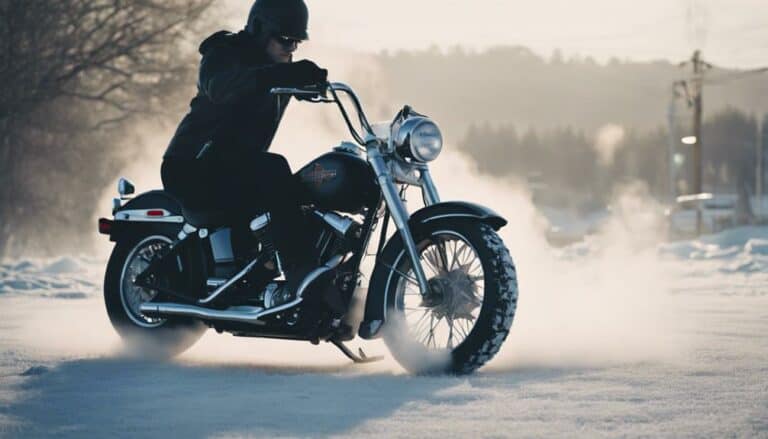If you’ve ever encountered challenges with your Harley Davidson starting up smoothly in colder temperatures, you might have experienced some common frustrations that riders face.
The initial sputter or prolonged cranking can be quite a nuisance, but understanding the underlying causes and effective solutions can make a significant difference in your riding experience.
By exploring key troubleshooting methods and practical tips tailored for cold weather conditions, you can enhance your bike’s performance and ensure a more reliable start every time.
Key Takeaways
- Use 20w50 synthetic oil to ease cold starts
- Ensure battery has high Cold Cranking Amps (CCA)
- Check for vacuum leaks and clean TMAP sensor
- Consider upgrading to a 1.4 kW (kilowatt) starter for easier starts
Common Causes of Cold Start Issues
If you’re experiencing cold start issues with your Harley Davidson, thick oil like 20-50 or straight 50 weight could be hindering the starting process. When the oil is too thick, especially in colder temperatures, it creates resistance for the engine to turn over, making it harder for your bike to start smoothly. To combat this, consider switching to a lighter oil that flows more easily during cold starts.
Additionally, having a free-flowing exhaust system can greatly improve cold start performance. By allowing better airflow, the engine can breathe more efficiently, enhancing the starting process. Another helpful tip is to utilize the choked and cranked starting method or use the accelerator pump to ensure the proper fuel charge is delivered into the cylinders, aiding in ignition.
Moreover, removing baffles from stock exhaust pipes can sometimes enhance cold start capabilities by reducing back pressure. Upgrading to a 1.4 kW (kilowatt) starter can also provide better cranking power, especially in colder weather conditions, for improved cold start performance on your Harley Davidson motorcycle.
Pre-Ride Preparation Checklist
Before embarking on your Harley Davidson ride, ensure to meticulously follow this pre-ride preparation checklist. Checking the battery voltage is crucial to ensure optimal performance during cold starts. Inspect the fuel filter to guarantee proper fuel flow, a key factor in combating hard starts in cold weather. Cleaning the TMAP sensor with a suitable cleaner can greatly improve cold weather starting, enhancing your overall riding experience. Consider using synthetic oil with a viscosity of 20w50 to provide better lubrication during cold starts. Additionally, verify the engine system for any vacuum leaks as these can lead to starting issues, especially in cold temperatures.
| Pre-Ride Preparation Checklist | |
|---|---|
| Battery Voltage | Check for optimal performance |
| Fuel Filter | Inspect for proper fuel flow |
| TMAP Sensor | Clean with compatible cleaner |
| Synthetic Oil | Consider 20w50 viscosity |
Cold Weather Starting Tips
To improve your Harley Davidson’s cold weather starting reliability, prioritize utilizing a high Cold Cranking Amps (CCA) battery. A battery with higher CCA can provide the necessary power to start your bike in cold conditions.
Additionally, plugging your Harley into a battery tender during winter storage is crucial for maintaining the battery’s health and ensuring easier starts when the cold weather hits.
Choosing the right oil viscosity for cold weather conditions is also essential as it enhances cold start reliability by ensuring proper lubrication during startup.
It’s advisable to carry a jump pack or emergency starting kit as a backup for challenging cold starts, providing an alternative power source when needed.
Keeping the battery connections clean and tight is equally important to ensure optimal electrical performance in cold weather.
Troubleshooting Cold Start Problems
When troubleshooting cold start problems on your Harley Davidson, start by checking for vacuum leaks to ensure the correct air-fuel mixture for optimal starting performance.
Here are some steps to troubleshoot cold start issues effectively:
- Check for vacuum leaks: Inspect hoses and connections for any leaks that could disrupt the air-fuel ratio.
- Replace the fuel filter: A clogged fuel filter can impede fuel flow, especially in colder temperatures.
- Clean the TMAP sensor: Use a suitable cleaner to remove dirt or debris that may affect sensor readings critical for starting.
- Consider synthetic oil: Switching to a lower viscosity synthetic oil like 20w50 can improve cold weather starting capabilities.
- Verify battery strength: Ensure the battery is in good condition and has ample power to support cold start-ups without issues.
Professional Maintenance Recommendations
For more efficient maintenance of your Harley Davidson’s starting system, prioritize checking for vacuum leaks as part of professional maintenance recommendations. Vacuum leaks can disrupt the air-fuel mixture, causing difficulties in starting your bike, especially in cold weather. Another crucial step is replacing the fuel filter to ensure proper fuel flow, aiding in the initial start-up process. Cleaning the TMAP sensor with a suitable cleaner is also recommended to improve cold weather starts. Opting for synthetic oil with a viscosity of 20w50 can enhance your Harley Davidson’s performance during cold starts. Additionally, always ensure your battery is in good condition to prevent first start-up problems. Here’s a table summarizing these professional maintenance recommendations:
| Maintenance Recommendation | Description |
|---|---|
| Vacuum Leaks | Check for leaks affecting air-fuel mixture. |
| Fuel Filter | Replace to ensure proper fuel flow. |
| TMAP Sensor | Clean with compatible cleaner for improved starts. |
| Synthetic Oil | Use 20w50 oil to enhance cold weather starting. |
| Battery | Ensure the battery is in good condition. |
Conclusion
In conclusion, tackling a hard-to-start Harley Davidson in cold weather is like navigating a frozen road – challenging but manageable with the right tools and know-how.
By understanding the common causes, prepping your bike, and following cold weather starting tips, you can conquer the cold start issue.
Remember, just like a well-plowed path, proper maintenance and troubleshooting will pave the way for smoother rides in chilly conditions.


you mention upgrading to a 1.4 volt starter? do you mean 14 volts?
Hi Will, thanks for pointing that out. It should be 1.4 kW (kilowatt) starter, not 1.4 volts. I’ll correct it. Appreciate your feedback!